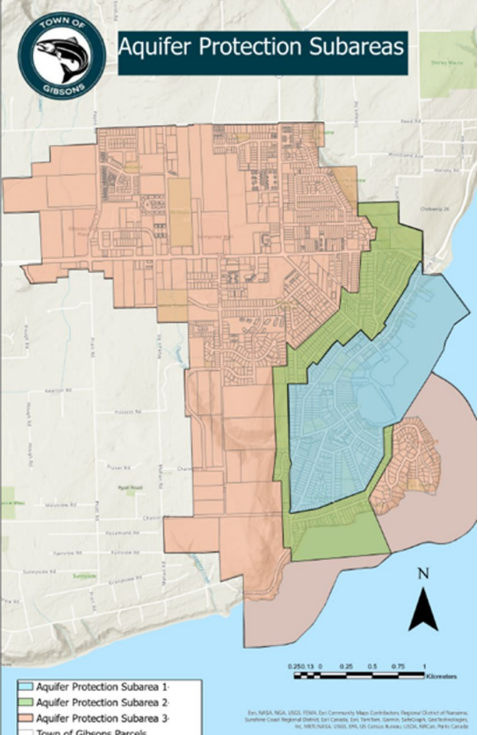Gibsons’ residents will see new safeguards for their drinking water as the town rolls out new rules governing development near critical underground water sources.
During its May 20 committee of the whole, council members moved forward with a comprehensive new aquifer protection bylaw designed to regulate development better while protecting the community's groundwater resources.
The bylaw, which received unanimous committee approval to proceed, represents a significant overhaul of existing water protection regulations.
The proposed legislation was first presented in July 2023. The new bylaw would replace the current Development Permit Area 9 (DPA 9) regulations with a more structured three-stage permitting process.
"Rather than having it all come [in] one package, which there's a lot to tease out, and there's very little direction for the applicants as well as the reviewers," explained Trevor Rutley, Gibsons’ director of infrastructure.
The new system aims to provide clearer administrative guidance and eliminate redundancies between existing regulations.
Under the proposed framework, developers would need to obtain three separate permits for projects involving ground disturbance in aquifer protection areas.
The process begins with a hydrogeological investigation permit, allowing applicants to bring in drilling equipment to assess aquifer conditions and depth. This initial step provides data needed for designing future development phases while ensuring the aquifer remains protected.
The second stage involves obtaining a geotechnical permit, which would be limited to exploring areas above the aquifer based on information gathered during the hydrogeological investigation. Last, developers would apply for an excavation permit to install servicing and build foundations, with approvals based on detailed excavation plans that don't exceed safe depths.
Rutley said the permit fee for the hydrogeological investigation would be the highest, with subsequent permits costing less as more data becomes available.
The bylaw establishes three sub-areas with different depth restrictions based on aquifer proximity.
Sub-area one, covering lower Gibsons, where the aquifer is in artesian condition (a groundwater storage area where water is under pressure), maintains the current 1.5-metre depth trigger for permits.
Sub-area two, a relatively narrow band of properties primarily on the mid-slope between Lower Gibsons and Upper Gibsons, allow excavation up to five metres before requiring permits. Sub-area three encompasses the remainder of land within the Town of Gibsons, excluding areas where bedrock is at or very near the surface, permits depths up to 30 metres in areas where the aquifer is significantly deeper.
"We've given ourselves a factor of safety," said Rutley.
Rutley added that actual aquifer depths exceed the permitted excavation limits in each zone and that the 30-metre threshold in sub-area three accommodates standard seismic soil testing requirements under building codes.
Coun. Annemarie De Andrade praised the initiative and noted it would help both council and developers navigate the regulatory process more effectively.
Coun. Stafford Lumley asked about insurance requirements. Staff said that insurance levels would be determined using Municipal Insurance Agency of BC (MIABC) risk matrices, though the specific work type may require additional consultation.
The enforcement provisions include fines up to $5,000. Lumley questioned whether this amount provides a sufficient deterrent. Rutley indicated staff would pursue maximum allowable fines within provincial limitations.
Rutley said some of the challenges with the current system revolve around a lack of clarity about what is permitted and relying heavily on the director's discretion.
He said the new system provides clear checkpoints and reduces regulatory uncertainty for both applicants and reviewers.
The committee unanimously recommended that the bylaw be forwarded for legal and technical review, then be brought before council for consideration.
While the new process required three separate permits instead one one, staff said it's expected to reduce the overall processing time.
Jordan Copp is the Coast Reporter’s civic and Indigenous affairs reporter. This reporting beat is made possible by the Local Journalism Initiative.
Words missing in article? Your adblocker might be preventing hyperlinked text from appearing.



